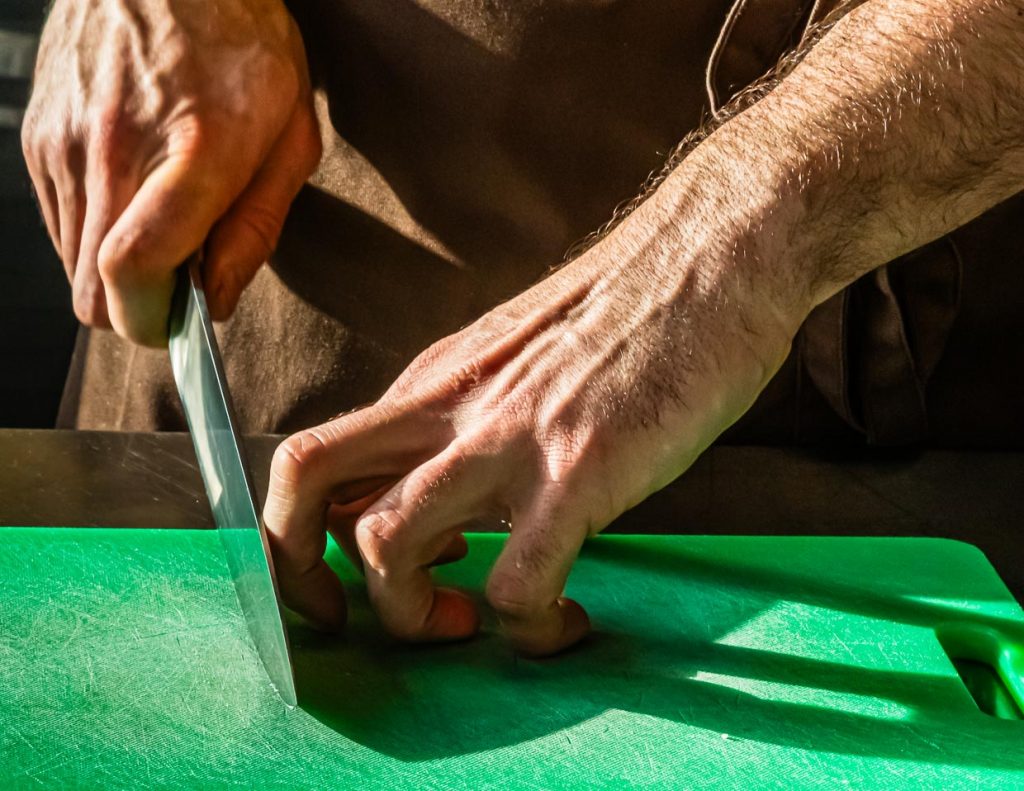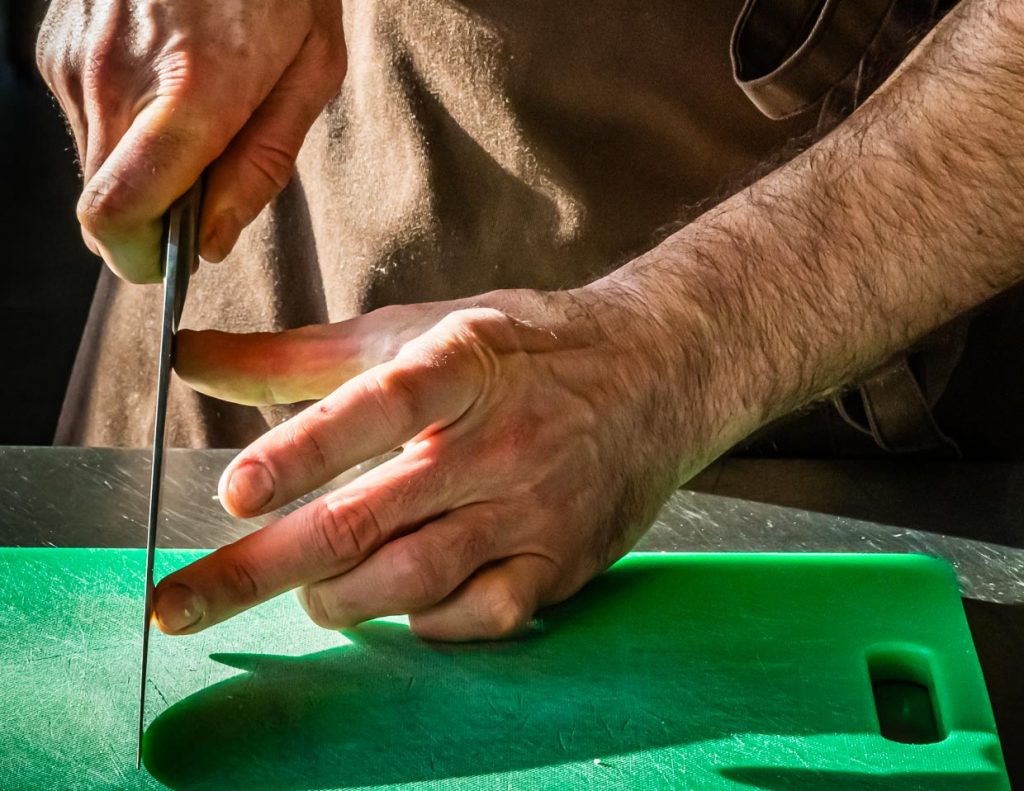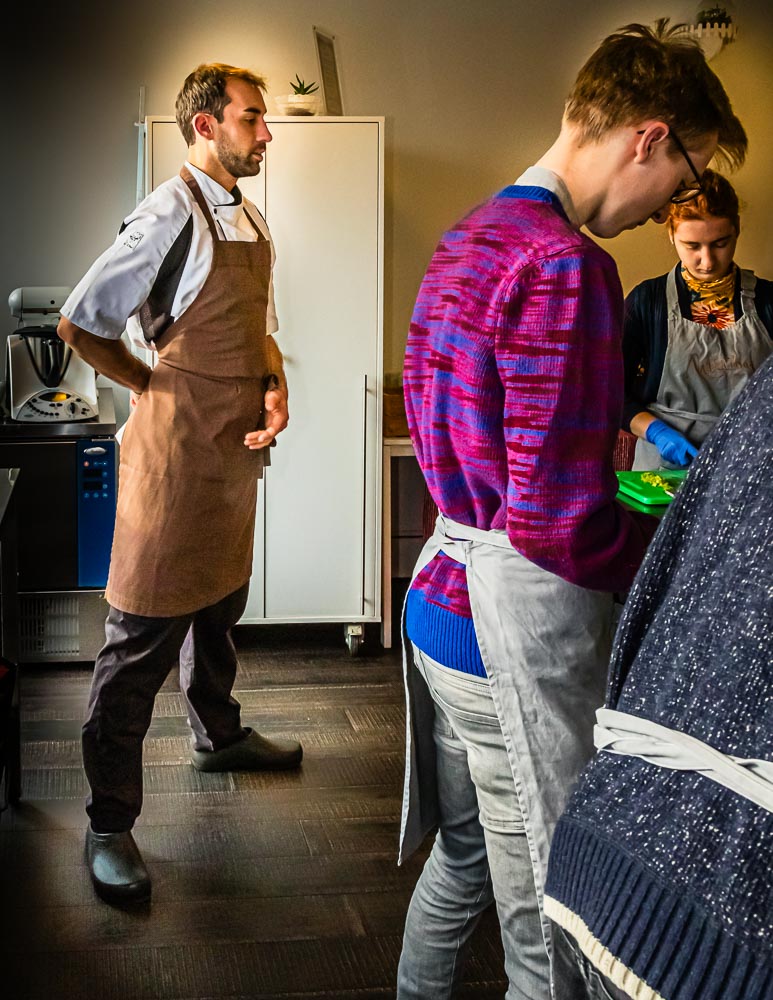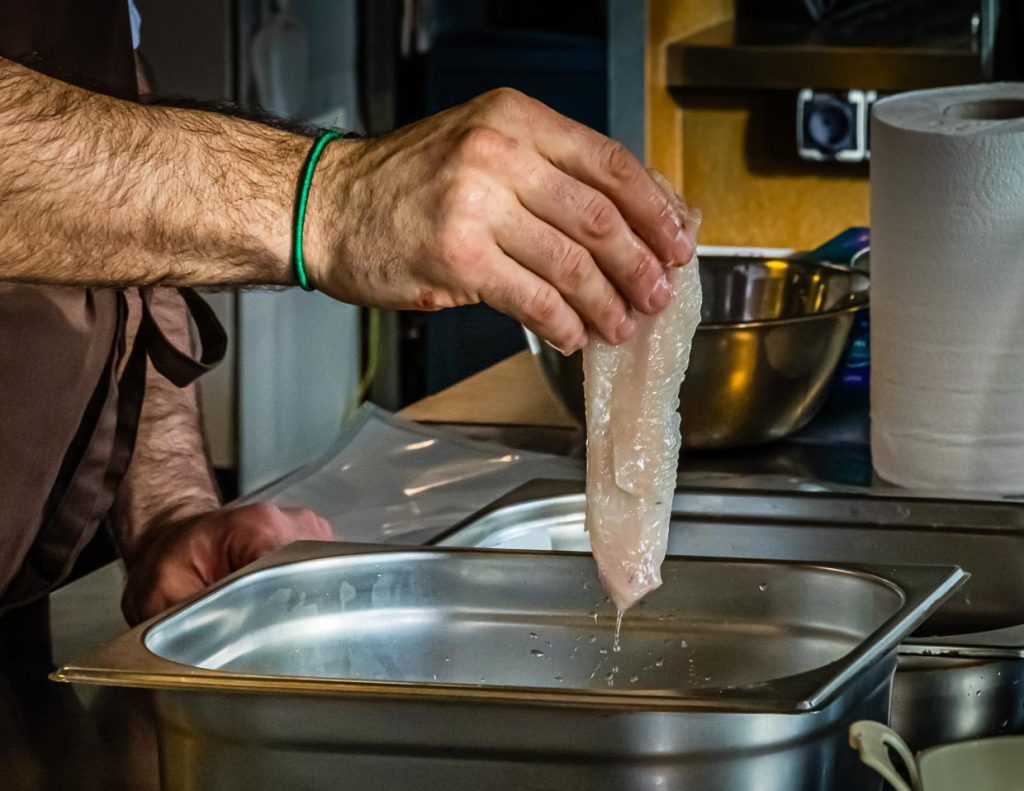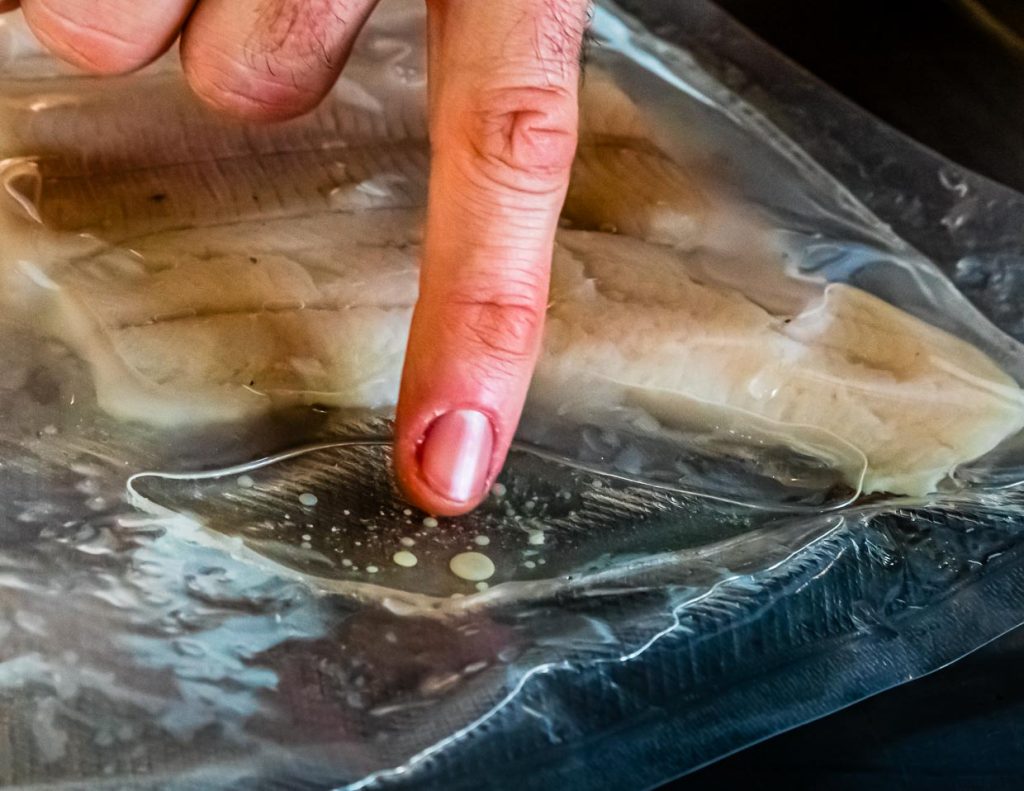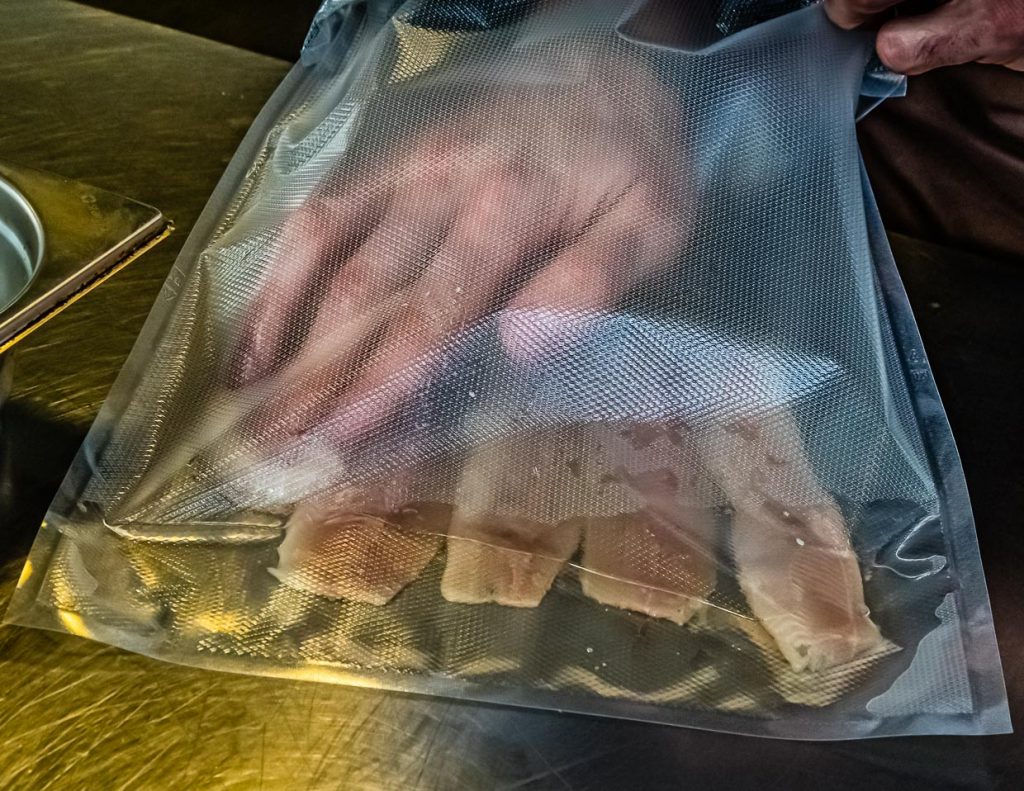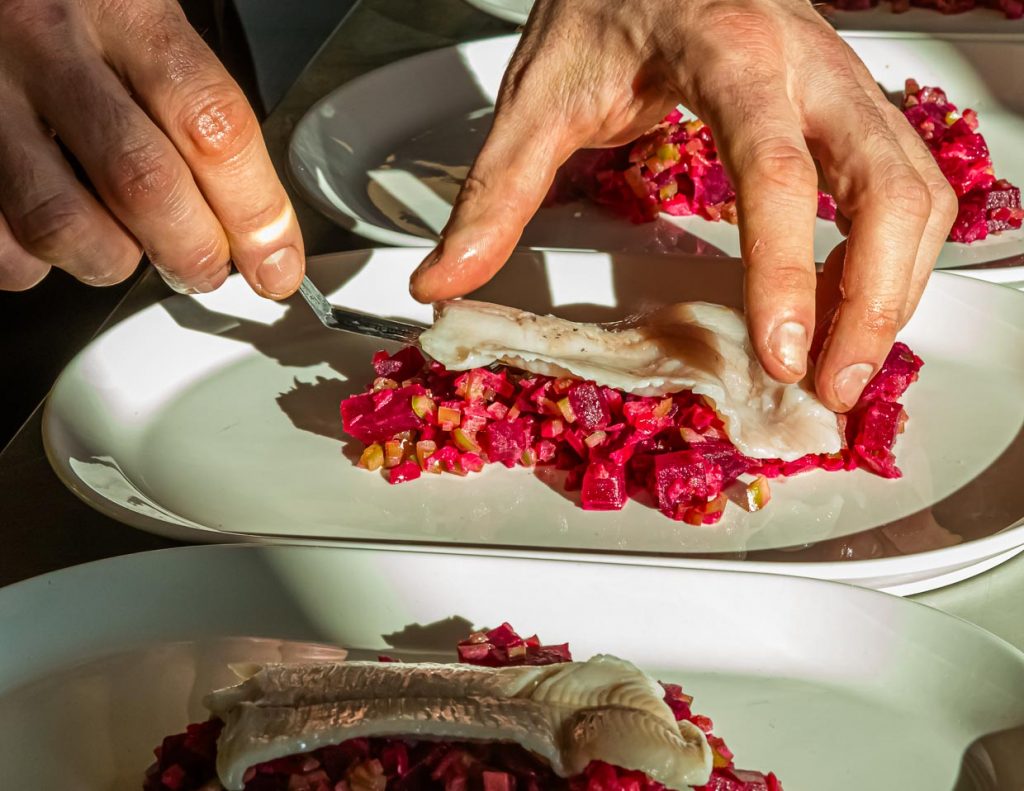“Make the sexy cut”
Where do you learn the best way to use a good chef’s knife? Answer: In a professional environment with a professional by your side. We met with professional chef László Papdi above the rooftops of Budapest at the Culinary Institute of Budapest. In his luggage a knife bag filled with different models.
These knives are the daily tools of many professional chefs and equally popular with amateur cooks. So that they also get something to do at the meeting in the cooking school of the Japanese Maki Stevenson, we have cuttings with us. In Budapest’s Great Market Hall we have previously bought trout, beet, onions and Hungarian green peppers.
So there’s plenty of practice material. Onions to be skinned and diced, hot peppers and tender fish for culinary students and chef’s knives alike to work on.

Maki Stevenson’s MakiFood cooking school and the Culinary Institute of Europe, which she founded in 2016, trains chefs for the restaurant industry in an annual course and also offers continuing education courses to laypeople. Born in Japan, she lived and worked in New York for a long time before coming to Budapest. In 2017, Maki Stevenson was honored as a culinary ambassador for her native Japan.

Fine Dicing – Fine dicing without tears
There are many tips to prevent weeping when cutting onions. From the category of impractical to silly come the tips to put on diving goggles or to cut the onion under water. More practical is to put the onion in the freezer for 10 minutes before cutting.
However, good technique and a sharp knife are still the most reliable basis for only moderate burning and tearing of the eyes. It is also helpful to know that the tearing is a protective reaction of the eyes from a gas that is produced when the onion cells are destroyed.
An onion consists of many cells from which two substances escape when cut: Alliin and Alliinase. Alliin is a sulfur-containing amino acid. During cutting, it comes into contact with the enzyme alliinase, which breaks it down in a chemical process. Allicin is formed, which reacts with moisture in the air to form an irritant gas. That is why we often feel like crying when cutting an onion.




Onion cutting with László Papdi. Whether cutting an onion is tearful or tearless depends largely on the cutting technique and the sharpness of a knife / © Photo: Georg Berg
László shows how it’s done. To prevent the onion from falling apart and its chopping ending in a messy slaughter, cut the onion in half right through the root base. Each half of the onion should still hold together. Cut the halved onion finely from the top with a chef’s knife without cutting through the root base.
Then make one or two horizontal cuts, depending on the size of the onion. The third cut is then parallel to the root base and you cut down nice little onion cubes. László is convinced that cutting the onion without tears is also a matter of training. After many thousands of onions he has already cut in his career, the irritant gas no longer shows much effect on him.

Good technique – good chef’s knife equipment
The Chroma Type 301 is made of Pure 301 stainless Japanese knife steel, which gives this series its name. A material that is easy to resharpen. A striking feature is the bead on the handle. It is a sensory stopper and shows the user the end of the handle. Of course, the knife is cleaned only under running water and never in the dishwasher.
Knife cutting technique with László Papdi / © Photo: Georg Berg
The basic cutting posture: the middle finger always dances forward on the fingertip and is closest to the knife blade. When guiding the knife in the cradle technique, the tip of the knife stays on the surface and the middle part of the knife blade does the cutting work. Of course, in order to have a lot of pleasure in the preparation otherwise, the quality of the knives is also important.
The right posture – from dancer to chef
Why does a cook become a chef? Often it is the school grades that lead to the stove. Many classic late starters in the school system find their mission in cooking and later lead themselves and their team to the highest honors. Often the talent runs in the family. If grandmother or mother are excellent cooks they may be born with a passion for cooking.
The story of Lázsló Papdi, however, is crazier. No one in his family had any professional involvement in gastronomy. László had already embarked on another professional career before he began his training as a chef at the age of just 19. As a trained dance teacher and ballroom dancer, he participated in international competitions. His then-girlfriend’s father, a chef in a Michelin-starred restaurant, got him interested in high-end gastronomy. László dared to take a lunge towards a new discipline.
The inner and the outer attitude is important for Laszlo Papdi not only in dancing but also in the kitchen.
After working in England, Denmark, Norway, Spain, Germany and Switzerland, the 34-year-old returned to Hungary. Works in the bistro of the star restaurant Stand, teaches at the Culinary Institute of Europe, assists the team of star chef Támas Széll in the performance for the Bocuse d’Or 2019 – and continues to give dance lessons.
The influence of his initial training can still be seen in his “cut and step” today. László stands at the work table as if he’s just done a sideways step to Fox Trott.
Not a bad prerequisite for a long cooking life, if the posture is right, because the often bent posture while cooking gets many cooks in the back over the years / © Photo: Georg Berg

Pas de Deux for trout sous vide!
The night before, we had also tried a trout cooked sous vide at Stand25 the bistro offshoot of the Michelin-starred restaurant Stand. The fish tasted fantastic, tender and pleasantly salty, as if it had taken a trip to the sea.

The self-imposed task for our cooking workshop was now to recreate trout sous vide. On the way to shapely trout fillets, some rough cuts are made first: Fins including cartilage and the head off and then it goes to the fish under the skin.


Make the sexy cut – shapely trout fillets
The closer we get to trout, the trickier the matter becomes. It’s not up to the equipment. The filleting knife from Chroma pulls along butter-softly between trout skin and flesh. Rather, it is the still bumpily applied technique. Without László’s guiding hand, there would have been even less meat left on one or two trout fillets. For the sake of appearance, László adds what he calls the “sexy cut” at the end.




Pas de Deux on the trout / © Photos: Georg Berg
For the cooking method that follows, it is irrelevant whether the fish is particularly shapely or not. The fillets are placed in a salt water bath for 10 minutes. The right ratio of water to salt is important. Here we take 1 liter of water and add 100 g of fine sea salt. Then the fillets go into a sous vide bag with some neutral oil.
The water bath is heated to 60 degrees. The bag is held in at about 56 degrees for about 2 minutes. An indication that the fish is cooked and should now leave the water bath is when the first beads of coagulated protein come out. Fish cooked sous vide is immensely juicy and flavorful.
Even if the student fillets are anything but perfectly formed, the presentation on the plate is still professionally pulled through: Trout Sous Vide / © Photos: Georg Berg


